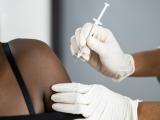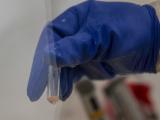Dec 19, 2001 (CIDRAP News) – Because of a small theoretical risk that anthrax spores can hide in the lungs for up to 100 days and grow after antibiotic treatment is stopped, the anthrax vaccine and an extension of antibiotic treatment will be offered to people who may have been exposed in the recent anthrax attacks, federal health officials announced yesterday afternoon.
The decision by the Department of Health and Human Services (HHS) stems from a concern that people who are now finishing their recommended 60-day course of antibiotics could be at risk if anthrax spores can outlast that regimen.
"Out of an abundance of caution, the Department of Health and Human Services is supporting two additional options beyond the 60-day antibiotic course for those who may wish to take additional options," HHS Secretary Tommy Thompson said in a telephone press briefing. "One additional option would be to take antibiotics for another 40 days, while closely monitoring for illness or adverse reactions to the antibiotics. Another is to continue taking antibiotics for another 40 days, as well as to receive three doses . . . of the anthrax vaccine spread out over a 4-week period." People also have the option of simply finishing their 60-day antibiotic regimen and then staying alert for suspicious symptoms, he said.
Use of the anthrax vaccine for postexposure prophylaxis is considered experimental. The vaccine has been used to protect military personnel and workers in goat-hair processing mills from possible future exposure to anthrax (preexposure prophylaxis). The vaccine is not licensed for use as postexposure prophylaxis, but the Food and Drug Administration (FDA) has granted permission for this use under an "investigational new drug" application filed by the Centers for Disease Control and Prevention (CDC).
HHS officials emphasized that they are offering the vaccine and the extended antibiotic course as options, rather than recommending them, because the risk of late-erupting disease is theoretical and the vaccine has possible side effects. "As an investigational new drug, the vaccine would have to be given with the full informed consent of the individual as to possible risks," Thompson said.
D. A. Henderson, director of the Office of Public Health Preparedness, said that in the face of much uncertainty, officials decided it is best to simply give people as much information as possible and let them decide for themselves what to do. "We're, in medicine, often faced with difficult decisions based on really inadequate information, and this is certainly where we are here," he said. Both the vaccine and the antibiotics can cause side effects, while the risk of getting sick from persistent spores is very low but is not zero, he added.
"There is risk and there are problems in taking any one of these courses of action," Henderson said. "So what we tried to do in this case is to lay it all out and say, 'Here's where we are, this is what we know, and there are three options out there.' The question what any of us would do, I suspect we might differ among ourselves."
The Department of Defense (DoD) has sold 220,000 doses of anthrax vaccine to HHS, Thompson said. Another HHS official at the Tuesday briefing said vaccinations of Senate staff members who may have been exposed because of contaminated letters sent to two senators might begin as early as today. The postal workers union has asked for an education program to inform workers about their options, but vaccinations of postal workers could start this week as well, the official said.
CDC Director Jeffrey Koplan, MD, said he couldn't predict how many people are likely to opt for the vaccine. HHS officials have estimated that about 3,000 may have been exposed to heavy doses of anthrax spores, making them the prime candidates for the vaccine.
The suspicion that anthrax spores can lurk in the body more than 60 days is based on animal studies. In the recent attacks, no cases of inhalational anthrax have occurred in people who took antibiotics for 60 days or stopped taking them sooner. Henderson said no cases have occurred in humans later than 43 days after exposure.
Anthony Fauci, MD, director of the National Institute of Allergy and Infectious Diseases, stressed that the risk of spores persisting beyond 60 days is theoretical. In one study in the 1950s, animals that were exposed to anthrax and then treated with antibiotics for 10 or 20 days still had traces of spores in their lungs after 100 days, he said during the press briefing.
The decision to offer the vaccine and prolonged antibiotic treatment came in the wake of a public forum convened in Washington, DC, by the CDC on Saturday (Dec 15). Anthrax experts there discussed exposure risks at sites targeted in the recent attacks and examined the risks and benefits of the vaccine and antibiotic treatment. A transcript of the meeting was posted on the CDC Web site yesterday (see link below).
The anthrax vaccine has been dogged by safety questions. About half a million military personnel have been vaccinated in recent years, and some have complained of chronic health problems that they blame on the vaccine. In addition, the sole US manufacturer of the vaccine, Bioport Corp. of Lansing, Mich., has been unable to market the vaccine for more than a year because it is waiting for the FDA to approve renovation work at the plant.
At Saturday's meeting, Lt. Col. Phil Pittman said about 30% of men and 60% of women report a mild local reaction to the vaccine, with many women developing a subcutaneous nodule. Smaller numbers report systemic symptoms such as rash, headache, or joint aches. These reactions last only a few days, Pittman said. Severe allergic reactions have occurred in about 1 in 100,000 people.
Also at the Saturday meeting, Kathy Zoon, director of the FDA's Center for Biologics Evaluation and Research, said the first 10,000 vaccine doses being transferred from DoD to HHS were made by Bioport after its plant renovation. "Although that 063 [the lot from which the doses come] meets all the specifications of the anthrax vaccine, it is not licensed yet because the inspection is ongoing," she said. If the inspection reveals no problems that would affect that lot, it will be "licensable," she said.
Another 200,000 doses of vaccine that DoD is transferring to HHS were manufactured in 1992 and should be used only in an emergency because their preservative content is slightly low, Zoon said. The lot passed preservative effectiveness tests in 2000 and potency tests in 1998, but it "would not ever meet the specifications for licensure," she said. "But there is no reason to expect that the side effects from this lot would be problematic."
"The only reason that these [doses] would be considered . . . is an emergency situation with full informed consent on the nature of the product and what the deviations were," Zoon said. Dixie Snider, a CDC official, commented that the doses could be used if needed because of additional major anthrax attacks or large numbers of new cases.
At Tuesday's briefing, HHS officials said they expect that the first 10,000 doses will be enough for those who request vaccination in response to the current offer. They said a 3-dose regimen is being offered because it should be enough to protect people for a few months. The normal regimen for preexposure prophylaxis is 6 doses over 18 months, with annual boosters thereafter.
See also:
Transcript of Dec 18 CDC briefing on the decision to offer anthrax vaccine and extended antibiotic treatment
http://www.cdc.gov/media/transcripts/t011218.htm
Transcript of Dec 15 forum, "Optimizing Post-Exposure Prevention of Inhalational Anthrax: Issues and Options"
http://www.cdc.gov/media/transcripts/1215HHStranscript.pdf
Dec 18 DHHS press release about the offer of anthrax vaccine and continuation of antibiotics
http://archive.hhs.gov/news/press/2001pres/20011218.html


















